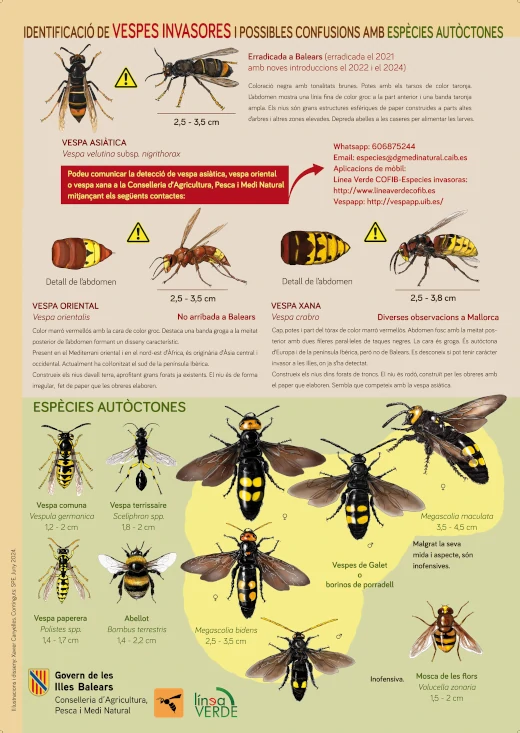Asian hornet, registered as an invasive exotic species in the Spanish Catalogue, has returned to Mallorca after two years without observing any activity of the species, for which it had been declared eradicated on the island. Specifically, four nests have been detected and eliminated in the municipality of Palma between the months of April and June this year, according to the Ministry of Agriculture, Fisheries and Natural Environment, through the Species Protection Service.
The danger of the Asian hornet lies in its exponential growth dynamics, posing a risk to native species that can be displaced from their natural habitats and potentially disappear. More information about invasive species can be found in this article published in Mallorca Global Mag. The located nests have already been sent to the University of the Balearic Islands (UIB) for genetic study to determine their origin.

The Asian hornet poses a threat to native species due to its reproductive capacity. Photo: CAIB.
Citizen collaboration
To aid in its elimination, authorities are requesting citizen collaboration to detect the Asian hornet in Mallorca. In this regard, the minister Joan Simonet noted that “the prevention of the arrival of new individuals is as important as the control of the species. Therefore, we ask the public for their cooperation in the rapid detection of this species. We remind you that we have various information channels for receiving reports, considering that it is a difficult to detect insect with a very high and exponential reproductive capacity.” Sightings can be reported through the following channels: WhatsApp (606875244), email (especies@dgmedinatural.caib.es), the COFIB Green Line – Invasive Species (www.lineaverdecofib.es), and Vespapp (vespapp.uib.es/).
Simonet also explained that, to help better understand the Vespa velutina and other possible invasive hornets and differentiate them from native species, “the Ministry of Agriculture, Fisheries and Natural Environment has created a new infographic -which we present below- with drawings by the illustrator and entomologist Xavier Canyelles.”

History of the presence of the Asian hornet in Mallorca
The Asian hornet was first detected in Mallorca in 2015 with the discovery of a nest in the municipality of Sóller. This nest was removed thanks to the joint intervention of the Species Protection Service, the Consortium for the Recovery of Wildlife of the Balearic Islands (COFIB), the UIB zoology laboratory, environmental agents, and beekeepers’ associations.
In 2016, nine nests were located, leading to the start of a control and eradication campaign. This campaign included the installation of bait traps, active research, and the removal of all found nests, aiming to limit the spread of the species. In 2017, the spread of the Asian hornet continued with the removal of up to 20 nests throughout the season.
The trend changed in 2018, a year in which only one nest was detected. In 2019 and 2020, no specimens were captured nor were there any positive reports from the population. After two years without observing any activity of the species, in 2021, the Asian hornet was officially declared eradicated in Mallorca, making it the first European territory to achieve this.
However, in the summer of 2021, the Species Protection Service received a positive report. COFIB located and removed one nest on a plot in the Son Ramonell urbanization in Marratxí. Genetic analysis by the UIB concluded that the hornets came from a different strain from the first wave, indicating a new introduction. During 2022 and 2023, no presence of the Asian hornet was detected, although negative reports continued to be received.







Leave A Comment